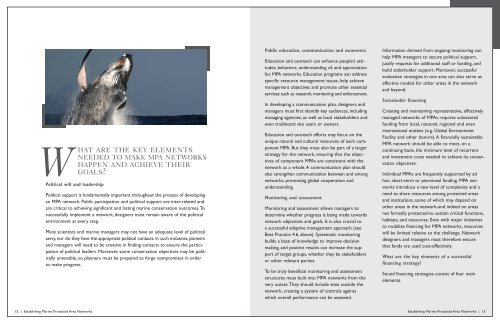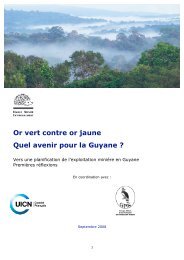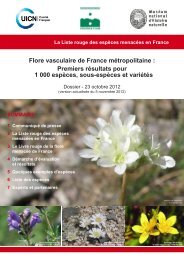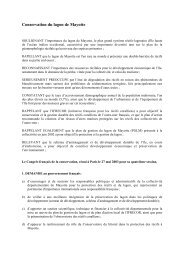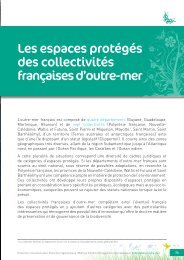Establishing Marine Protected Area Networks - Georgia Strait Alliance
Establishing Marine Protected Area Networks - Georgia Strait Alliance
Establishing Marine Protected Area Networks - Georgia Strait Alliance
Create successful ePaper yourself
Turn your PDF publications into a flip-book with our unique Google optimized e-Paper software.
WHAT ARE THE KEY ELEMENTS<br />
NEEDED TO MAKE MPA NETWORKS<br />
HAPPEN AND ACHIEVE THEIR<br />
GOALS?<br />
Political will and leadership<br />
Political support is fundamentally important throughout the process of developing<br />
an MPA network. Public participation and political support are inter-related and<br />
are critical to achieving significant and lasting marine conservation outcomes.To<br />
successfully implement a network, designers must remain aware of the political<br />
environment at every step.<br />
Many scientists and marine managers may not have an adequate level of political<br />
savvy, nor do they have the appropriate political contacts. In such instances, planners<br />
and managers will need to be creative in finding contacts to ensure the participation<br />
of political leaders. Moreover, some conservation objectives may be politically<br />
untenable, so planners must be prepared to forge compromises in order<br />
to make progress.<br />
Public education, communication and awareness<br />
Education and outreach can enhance people’s attitudes,<br />
behaviors, understanding of, and appreciation<br />
for, MPA networks. Education programs can address<br />
specific resource management issues, help achieve<br />
management objectives and promote other essential<br />
services such as research, monitoring and enforcement.<br />
In developing a communication plan, designers and<br />
managers must first identify key audiences, including<br />
managing agencies, as well as local stakeholders and<br />
even traditional site users or owners.<br />
Education and outreach efforts may focus on the<br />
unique natural and cultural resources of each component<br />
MPA. But they must also be part of a larger<br />
strategy for the network, ensuring that the objectives<br />
of component MPAs are consistent with the<br />
network as a whole.A communication plan should<br />
also strengthen communication between and among<br />
networks, promoting global cooperation and<br />
understanding.<br />
Monitoring and assessment<br />
Monitoring and assessment allows managers to<br />
determine whether progress is being made towards<br />
network objectives and goals. It is also crucial to<br />
a successful adaptive management approach (see<br />
Best Practice 4.6, above). Systematic monitoring<br />
builds a base of knowledge to improve decision<br />
making, and positive results can increase the support<br />
of target groups, whether they be stakeholders<br />
or other relevant parties.<br />
To be truly beneficial monitoring and assessment<br />
structures must built into MPA networks from the<br />
very outset.They should include sites outside the<br />
network, creating a system of controls against<br />
which overall performance can be assessed.<br />
Information derived from ongoing monitoring can<br />
help MPA managers to secure political support,<br />
justify requests for additional staff or funding, and<br />
build stakeholder support. Moreover, successful<br />
evaluation strategies in one area can also serve as<br />
effective models for other areas in the network<br />
and beyond.<br />
Sustainable financing<br />
Creating and maintaining representative, effectively<br />
managed networks of MPAs requires substantial<br />
funding from local, national, regional and even<br />
international entities (e.g. Global Environment<br />
Facility and other donors).A financially sustainable<br />
MPA network should be able to meet, on a<br />
continuing basis, the minimum level of recurrent<br />
and investment costs needed to achieve its conservation<br />
objectives.<br />
Individual MPAs are frequently supported by ad<br />
hoc, short-term or piecemeal funding. MPA networks<br />
introduce a new level of complexity and a<br />
need to share resources among protected areas<br />
and institutions, some of which may depend on<br />
other areas in the network-and indeed on areas<br />
not formally protected-to sustain critical functions,<br />
habitats, and resources. Even with major initiatives<br />
to mobilize financing for MPA networks, resources<br />
will be limited relative to the challenge. Network<br />
designers and managers must therefore ensure<br />
that funds are used cost-effectively.<br />
What are the key elements of a successful<br />
financing strategy?<br />
Sound financing strategies consist of four main<br />
elements.<br />
12 | <strong>Establishing</strong> <strong>Marine</strong> <strong>Protected</strong> <strong>Area</strong> <strong>Networks</strong> <strong>Establishing</strong> <strong>Marine</strong> <strong>Protected</strong> <strong>Area</strong> <strong>Networks</strong> | 13


